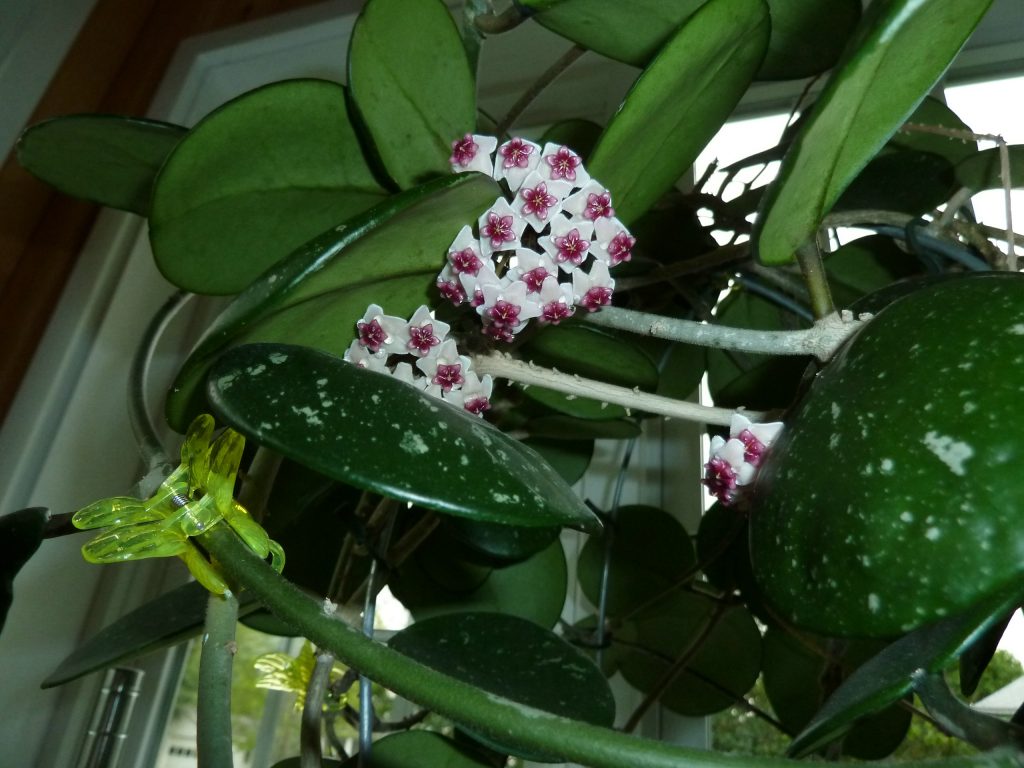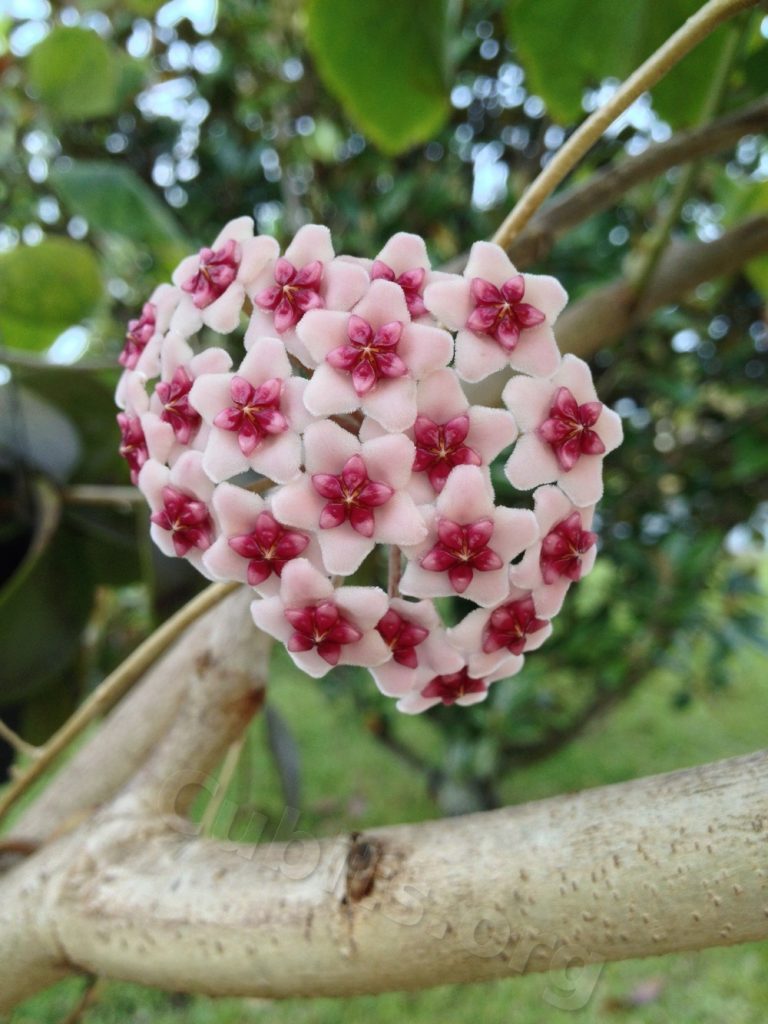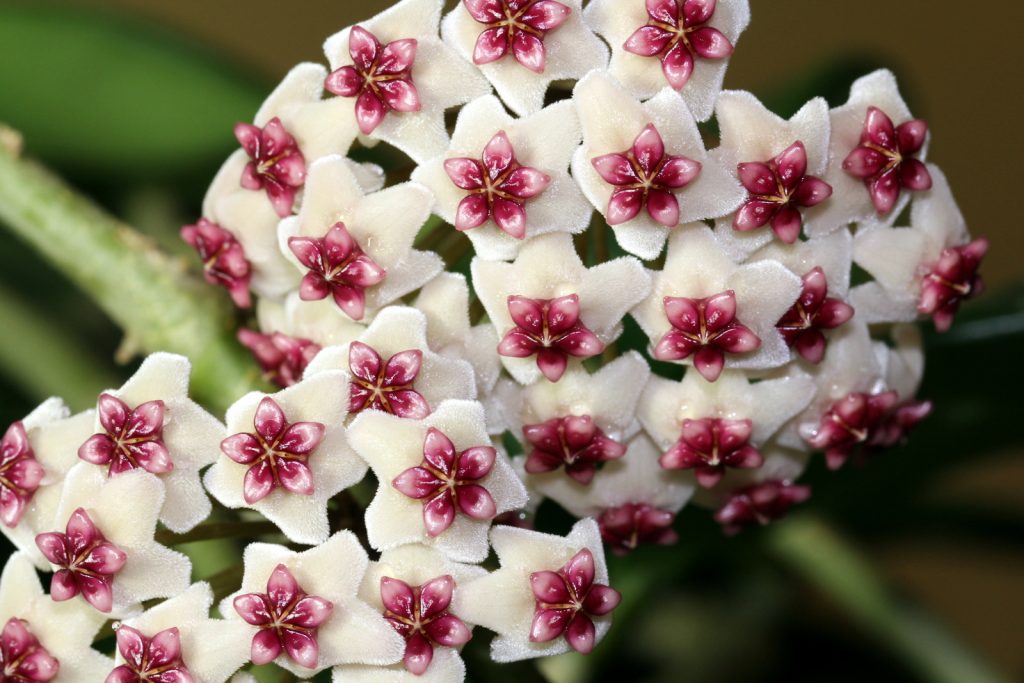Hoya Obovata - care secrets
Hoya Obovata is a tropical vine adapted for growing at home. Discovered at the end of the 19th century by the scientist Decken, traveling around the island of Butungu. It came to the territory of Europe only a century later. In its natural range, it grows in the woodlands of India, Thailand, Indonesia.

Hoya obovata variegata splash
Description of the plant
Hoya Obovata is characterized by a strong liana-like stem, which over time acquires a stiff structure. Curly shoots are covered with green fleshy leaves of a rounded shape with light pigmentation on the surface, 6-8 cm in diameter.
Flowering occurs in late spring. At this stage, the plant forms small buds, collected in inflorescences - 10-20 copies each. The flowers themselves are fluffy, outwardly reminiscent of asterisks, a powdery pink shade with a more saturated or dark crown in the center.
The aroma is honeyed with light notes of vanilla and specks. A large amount of colorless nectar is released.
Varieties
Variegata
It has a high growth rate. Climbing shoots acquire a brown tint over time.
The leaves are large, lobed. As with all variegated hybrids, there is pigmentation on the surface in the center of the plates, in this case located in the middle in the form of a pale yellow stripe.
The flowers are presented in two tiers: the upper one is milky, the lower one is rich crimson.
Splash
The variety develops moderately. The vegetative shoots need vertical support to maintain the integrity of the root system. They do not exceed 0.5 cm in diameter, in a young state they are reddish, with age they acquire a woody structure and a characteristic color.
Leaf plates without pronounced veins, covered with silvery stains and spots.
The flowers are five-pointed, of a delicate pink color with a rich crimson border. The flowering phase occurs in the spring.
Landing rules
After the purchase, it is recommended to isolate the culture for the first time - it is closely monitored in order to identify possible diseases and insects.
After 2 weeks, several copies of Obovata can be planted in one container, which allows you to compose a lush, spreading bush.

Hoya obovata
If the aboveground part is massive, the pot is equipped with supports to support the liana-like lashes.
Selection of soil and location
The substrate for Hoya is chosen to be nutritious and light, with good aeration and water permeability. Additionally, a drainage layer of clay shells, crushed brick, vermiculite or a mixture of sand with expanded clay is placed in the pot.
The optimal composition of the soil mixture:
- vegetable humus - 1 part;
- river sand - 1 part;
- sheet land - 1 part;
- peat - 4 parts;
- turf - 1 part.
The container for planting is medium in size with holes at the bottom, while planting in pots previously used for other green pets is not recommended.
The permanent location is determined immediately - due to systematic movement, foliage falls and flowering stops.
The necessary conditions
Despite the unpretentiousness of the plant, its owner will have to take care of some aspects when recreating the most favorable indoor microclimate.

Hoya obovata splash
Humidity
The air humidity must be kept at a high level. In this regard, regular spraying is carried out, especially during the heating period and in summer, in hot weather.
Temperature
Hoya belongs to the number of thermophilic plants, sensitively reacts to fluctuations in temperature and drafts.
In the summer months, the optimal values are 22-25 ° C, in winter they are reduced to 15.
Hypothermia of the culture should not be allowed - temperatures below 10 ° C have a detrimental effect on the health of the flower.
Lighting
Obovata prefers a plant in a well-lit place, but the light should be diffused.
When located on the south side, it is recommended to artificially shade the plant. Otherwise, burns may appear on the surface of the sheet plates, provoked by direct sunlight.
Care
Watering
Complete drying out of the soil should be avoided, but excessive moisture is fraught with rotting of the root system.

Hoya obovata photo
Irrigation is done as the topsoil dries up - on average, in the summer, the procedure is carried out once a week, using a small amount of water. In the resting phase, the interval between waterings is increased by at least 2 times.
Additionally, it is recommended to wipe the sheet plates with a damp soft cloth.
Top dressing
In the stage of intensive growth and flowering, Hoya is fed with complex mineral preparations for cacti and succulents. From March to the last days of August, fertilizers are applied regularly, once every 2 weeks, after dissolving them in water for irrigation.
You can also use universal remedies, provided that the dosages indicated on the package are observed.
Transfer
Young specimens are transplanted annually, older ones are not moved to a new container for 2-3 years.
During the manipulations, the earthen lump is preserved as much as possible, in the future, for better adaptation, growth biostimulants are added to the liquid during irrigation.
Pruning
Under natural conditions, lashes of crops can grow up to 10 m, therefore, when growing at home, the vegetative shoots should be periodically shortened in order to control their length. It is allowed to make a haircut only after the formation of at least 4 leaves.
In addition, pinching the growing shoot stimulates the formation of lateral growth points and allows for more abundant flowering and foliage.
Reproduction methods
Seeds
Seeds are not formed on homemade Hoyas; you can buy them in a specialized store, while checking the freshness of the material.

Hoya obovata variegata
The pods are pre-dried, after which the contents are sown into a moistened substrate with a considerable proportion of sphagnum moss.
A week later, the seeds germinate under the condition of a warm microclimate and keeping the soil moist. In order to prevent fungal diseases, spraying with Bordeaux liquid is done.
After 3 months, when 3-4 true leaves appear, the seedlings are seated in separate containers.
Cuttings
The easiest way to reproduce Hoya, which allows you to get young plants extremely quickly. The procedure is carried out in early spring or summer, adhering to the following action plan:
- Cut short cuttings with 2-3 growth nodes and leaf plates present on them. Places of cuts are treated with a rooting stimulant.
- The sprouts are placed in a vessel with dark walls (if necessary, the transparent container is wrapped with food foil) so that the lower unit is immersed in liquid. They additionally increase the humidity of the air.
- After the formation of roots, they are transplanted into the soil mixture.
It is also allowed to root cuttings directly in the ground.
To do this, coarse sand or vermiculite must be added to the soil mixture. A shoot is inserted into it, the cut of which is pretreated with a biostimulator, deepening into the lower node, and germinated for 3 weeks.
After 4 years, the first flowering is observed.
Layers
A method of reproduction, thanks to which it becomes available to admire exotic flowers for 1 year from the moment of planting.
To achieve the result, the adult process is incised, covered with wet sphagnum on top and not very tightly wrapped in cellophane.
When the roots germinate through the moss, the stem with it is cut off completely and planted in the ground.
Sheet
The principle is similar to the method of propagation by cuttings, only a leaf plate with an axillary bud is used as a seed in this case.

Hoya obovata variegated
Minus - the rooting process takes a long period of time, and the plant often stops at the starting point.
Possible problems
Diseases
The Obovata variety is rarely exposed to any diseases, however, due to improperly organized care, the florist may face a number of changes in the appearance and condition of the plant.
| Problem | Cause | Solution method |
| Lack of flowering | Lack of light, high temperature during rest | During wintering, they organize a decrease in temperatures, increase insolation |
| Loss of buds | Plant relocation / dry and hot indoor climate | Refrain from transporting the pot from one place to another / regularly spray during the summer |
Pests
| Problem | Symptoms | Prophylaxis | Solution method |
| Root rot | Change in color of foliage, suspension in growth, brown spots, drying of leaves and the appearance of constrictions on them. Complete wilting of the aerial part of the plant | Before planting, they disinfect the soil by calcining, adhere to moderation in dressing, avoid excessive moisture of the substrate | The upper part of the stem, root collar and roots are treated with copper sulfate (1 tsp) diluted in water (0.5 l) and chalk (3 tablespoons) or with an iodine solution in a ratio of 1: 4. Sprayed with fungicides (Trichodermin, Trichophyte, Topaz, Previkur Energy, Gamair) |
| Spider mite | Brown spots with small punctures, drying leaves, light cobweb | Maintain air humidity at the required level, regularly spray and rinse under a weak pressure of water | Wipe with alcohol, soapy or onion solution, as well as infusion on dandelion or calendula roots. They are treated with chemicals (Fitoverm, Neoron, Antimite, Skelta, Flumite) |
| Shield | Convex plaques of a rounded shape, colored in various shades from green or yellow to brown | Timely dispose of injured and affected segments, periodically spill soil with a weak solution of potassium permanganate | Insecticides are used: Bankol, Inta-Vir, Aktara, Mospilan. Spray with alcohol at a concentration of 96%. |
| Whitefly | Yellowed deformed leaves, small flying insects initiated after touching the plant, black spots, shiny sticky coating | Ventilate the premises regularly, avoid excessive increase in air humidity | Hang up fly traps or turn on a mosquito fumigator. Spray with ash infusion or special preparations (Vermitek, Keramiks, Fitoverm) |
| Aphid | Leaves curl, pigmentation appears, growth stops, young shoots dry out | They remove plant residues in a timely manner, prevent the appearance of ants, systematically spray | They are processed with Spark, Tanrek or Aktara. The use of vinegar, ammonia or tar soap is allowed. |

